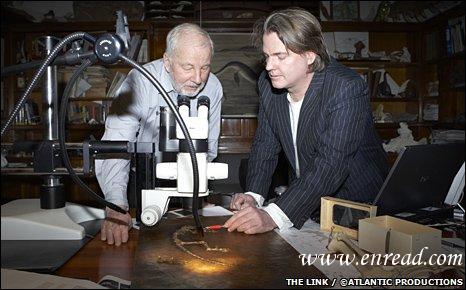| ||||||||||||||||||||||||||||||||||||||||||||||||||||||||||||||||||||||||||||||||||||||||||||||||||||||||||||||||||||||||
|
The beautifully preserved remains1 of a 47-million-year-old, lemur-like creature have been unveiled in the US. 美国发现完美保存的470万年的类似狐猴的动物化石。 The preservation2(保存) is so good, it is possible to see the outline of its fur and even traces of its last meal. The fossil, nicknamed Ida, is claimed to be a "missing link" between today's higher primates3 - monkeys, apes and humans - and more distant relatives. But some independent experts, awaiting an opportunity to see the new fossil, are sceptical of the claim. And they have been critical of the hype(大肆宣传,炒作) surrounding the presentation of Ida. The fossil was launched amid great fanfare4(喇叭或号角嘹亮的吹奏声) at the American Museum of Natural History in New York, by the city's mayor. Although details of the fossil have only just been published in a scientific journal - PLoS One - there is already a TV documentary and book tie-in(搭卖的). Ida was discovered in the 1980s in a fossil treasure-trove(埋藏于底下的宝藏) called Messel Pit, near Darmstadt in Germany. For much of the intervening period, it has been in a private collection. The investigation5 of the fossil's significance was led by Jorn Hurum of the Natural History Museum in Oslo, Norway. He said the fossil creature was "the closest thing we can get to a direct ancestor" and described the discovery as "a dream come true". The female animal lived during an epoch6(纪元,时代) in Earth history known as the Eocene, which was crucial for the development of early primates - and at first glance, Ida resembles a lemur(狐猴). But the creature lacks primitive7 features such as a so-called "toothcomb", a specialised feature in which the lower incisor(门牙) and canine8 teeth(尖牙) are elongated9(细长的), crowded together and projecting forward. She also lacks a special claw used for grooming10(修饰). The team concluded that she was not simply another lemur, but a new species. They have called her Darwinius masillae, to celebrate her place of origin and the bicentenary(二百周年纪念) of the birth of Charles Darwin. Dr Jens Franzen, an expert on the Messel Pit and a member of the team, described Ida as "like the Eighth Wonder of the World", because of the extraordinary completeness of the skeleton(骨架,纲要). It was information "palaeontologists can normally only dream of", he said. In addition, Ida bears "a close resemblance to ourselves" he said, with nails instead of claws, a grasping hand and an opposable(可相对的) thumb - like humans and some other primates. But he said some aspects of the teeth indicate she is not a direct ancestor - more of an "aunt" than a "grandmother". "She belongs to the group from which higher primates and human beings developed but my impression is she is not on the direct line." Independent experts are keen to see the new fossil but somewhat sceptical of any claim that it could be "a missing link". Dr Henry Gee11, a senior editor at the journal Nature, said the term itself was misleading and that the scientific community would need to evaluate its significance. "It's extremely nice to have a new find and it will be well-studied," he said. But he added that it was not likely to be in the same league as major discoveries such as "Flores man" or feathered dinosaurs12. Dr Chris Beard, curator(管理者) of the Carnegie Museum of Natural History and author of The Hunt for the Dawn Monkey, said he was "awestruck(充满敬畏之心的)" by the publicity13 machine surrounding the new fossil. He argued that it could damage the popularisation of science if the creature was not all that it was hyped up to be. Dr Beard has not yet seen scientific details of the find but said that it would be very nice to have a beautiful new fossil from the Eocene and that Ida would be "a welcome new addition" to the world of early primates. But he added: "I would be absolutely dumbfounded(惊呆的) if it turns out to be a potential ancestor to humans." In the PLoS paper itself, the scientists do not actually claim the specimen14 represents a direct ancestor to us. But Dr Hurum believes that is exactly what Ida is. He told BBC News that the key to proving this lay in the detail of the foot. The shape of a bone in the foot called the talus(趾骨) looks "almost anthropoid(像人类的,类人猿的)". He said the team was now planning a 3D reconstruction15 of the foot which would prove this. "We're not finished with this specimen yet," said Dr Hurum. "There will be plenty more papers coming out." 点击  收听单词发音 收听单词发音
|
||||||||||||||||||||||||||||||||||||||||||||||||||||||||||||||||||||||||||||||||||||||||||||||||||||||||||||||||||||||||
- 发表评论
-
- 最新评论 进入详细评论页>>




